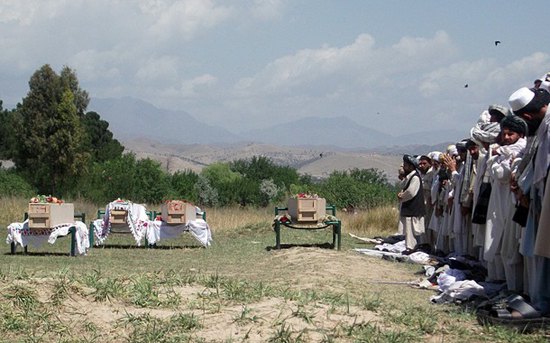By Alissa J. Rubin
KABUL, Afghanistan — A record number of Afghan civilians were killed in the conflict here last year, the majority at the hands of the Taliban and other insurgent groups whose use of homemade bombs became more prevalent and whose suicide bombers killed more people each time, according to the annual United Nations report on civilian casualties.
Although the number killed — 3,021 civilians — represented a relatively small 8 percent increase in casualties over 2010, it was the fifth straight year in which civilian casualties rose. The overall trend suggested that the fighting was worsening and that, for all the talk about peace efforts and a drastic increase in the number of insurgents that NATO had killed and captured, day-to-day dangers for Afghan civilians were rising.
“To the Afghan people, the credibility and value of a peace negotiation process and progress toward peace will be measured by reduced civilian casualties and improvements in security,” said Georgette Gagnon, the director of human rights for the United Nations office here and the leader of the team that produced the report.
“Only through increased actions to protect civilians will the relentless toll of death and injury to Afghan children, women and men be ended during and following a peace process.”
The report, which has been released in each of the last five years, records the deaths of all noncombatants based on the United Nations’ reporting and investigations, and it has come to serve as a grim metronome of the war.
Of the documented deaths, 77 percent were caused by the Taliban and other insurgent groups, an increase from 2010 despite repeated pledges by the Taliban to try to avoid killing civilians. By contrast, the number of civilians killed by pro-government forces, including NATO troops, the Afghan Army and government-backed militias, fell to 410, or 14 percent of the total killed. In 9 percent of cases, the party responsible was not clear.

Afghan mourners gather to pray by the flower-decorated coffins of four children in Khost province on April 20, 2010. Four students were killed April 19 in crossfire between foreign soldiers and insurgents in eastern Afghanistan, the education ministry said. (Photo: Getty Images)
The Taliban’s responsibility for a rising number of deaths raises questions about the sincerity of their public pledges to try to avoid harming civilians. In both the code of conduct issued under the name of the Taliban leader Mullah Muhammad Omar and in subsequent Taliban statements, the insurgents have pledged to be careful not to hurt civilians.
The Taliban and other insurgents have given accounts of receiving instructions from commanders in Pakistan and on the field in Afghanistan to look after civilians, according to a NATO report, leaked this week, that was based on thousands of interviews of detainees in Afghanistan. Yet the Taliban’s statements did not square with the facts, and they adopted increasingly harmful tactics, according to the United Nations report.
Most injurious were homemade bombs, which accounted for 967 deaths. Most are victim-activated antipersonnel mines, some so sensitive that a 45-pound child who treads on one while playing in a field can set it off, United Nations officials said. Such bombs do not differentiate between military and civilian targets and appear frequently to be scattered in areas regularly traversed by civilians.
Casualties from suicide bombings increased 80 percent, with 431 civilians dying in suicide attacks. The techniques used and the targeting of civilians were clear in most of those cases, the report said. Among the most devastating was one in Kabul on Dec. 6, when tens of thousands worshipers gathered to mourn Imam Hussein, one of the pivotal figures in the Shiite branch of Islam. A man wearing a suicide vest killed 56 people, according to the United Nations.
By contrast, there has been a gradual drop in casualties attributed to NATO troops since 2009. Although the drop was relatively small in 2011, it occurred despite intensive combat operations in southern and eastern Afghanistan. Generally, when NATO increases operations, there is also an increase in casualties. The United Nations praised NATO’s efforts both to adjust its tactical directives to troops and to retrain them to adhere to the new standards.
Still, aerial attacks by NATO accounted for the most civilian deaths of those attributed to government forces, with 187 people killed when NATO used aircraft to bomb houses it believed held insurgents.
Over all, the 39-page report charts a series of disturbing signs that suggest the country is becoming ever more dangerous for ordinary Afghans.
The report notes that more than 185,000 Afghans, a 45 percent increase over 2010 and more than in any previous year, were displaced in 2011, many as they fled conflict. The report also points out that while casualties caused by NATO are dropping, those that were the fault of Afghan government forces rose almost 200 percent just for the six-month period of June to December.
In that period, Afghan security forces killed 41 civilians, almost twice the number killed in the same six-month period in 2010. As Afghan forces take over more tasks currently carried out by NATO troops, there are serious concerns that casualties by pro-government forces could rise again.
One of the many Afghan civilians interviewed by the report’s authors described the underlying fear that many people live with here.
“I was late that day for work and missed the shuttle. A bomb hit their bus and killed them,” said the civilian, a member of the border police who works at an airport in Herat. “They were not just colleagues, they were my friends. It is difficult being a female police officer, and those women were my friends. We worked together, ate together and supported each other.”
She added: “My daughter is 9 years old, and every day before I leave for work, she cries and says, ‘Mama, don’t go to work. I don’t need to eat.’ ”



